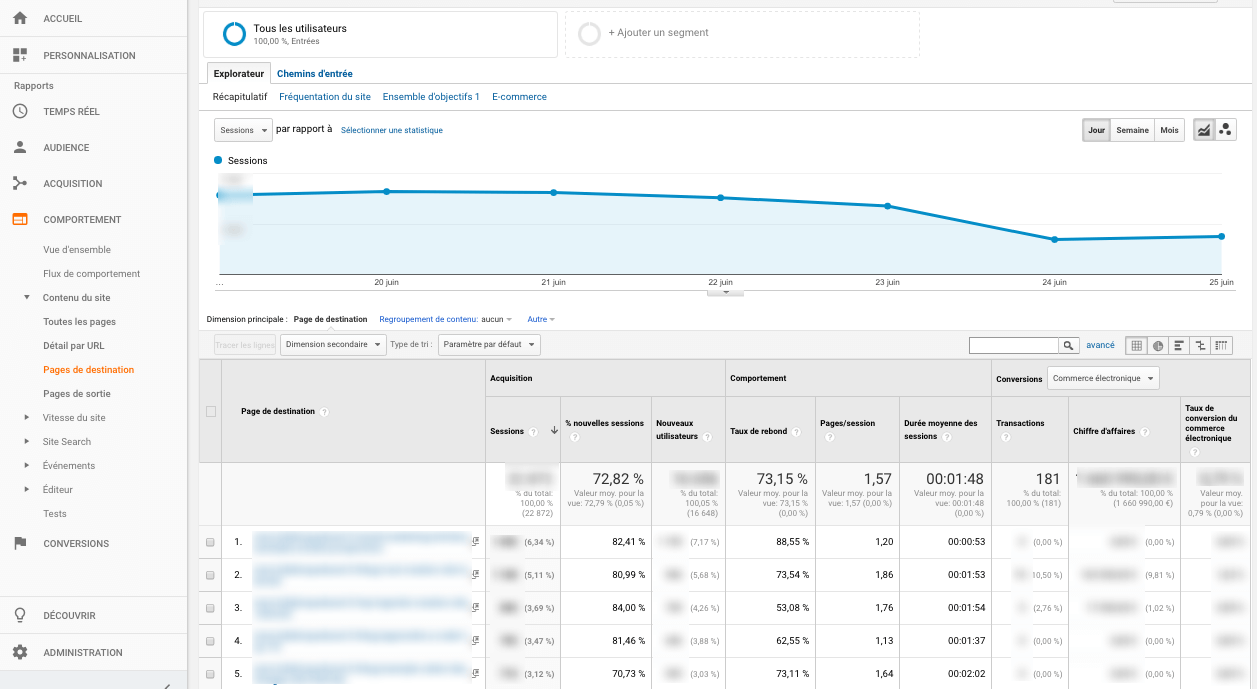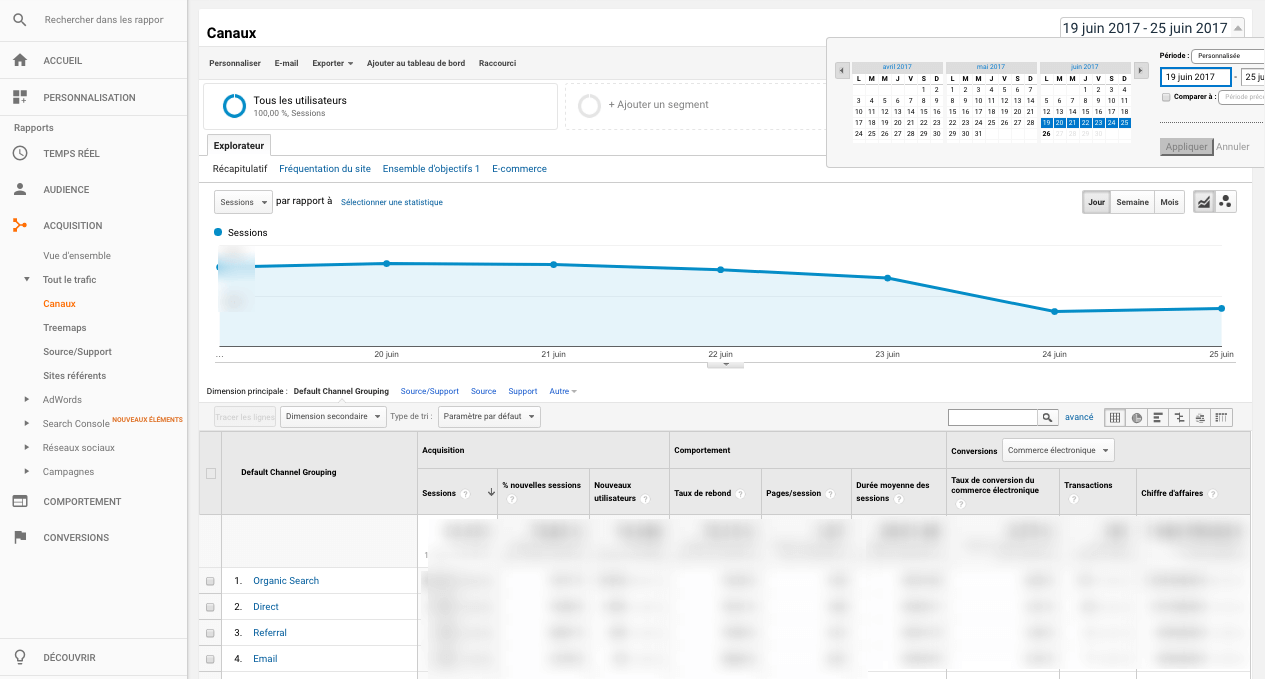Do you want to improve the quality of your website traffic? Are you looking to increase the number of website visits on your page? Eminence’s digital experts take a look in this article on how to optimize your traffic using your database.
Improve conversion rates with Google Analytics
It is very important to evaluate your website performance in order to refine and improve your online acquisition strategy. In this respect, Google Analytics is the ideal tool.
• Start increasing your conversion rate by analyzing your bounce rate
In Google Analytics, the bounce rate is one of the most important metrics for the quality of your website. It enables you to identify key areas that generate interest among Internet users. This said, it is often misinterpreted.
In fact, the bounce rate has nothing to do with the time spent on the website. It is an indicator of the percentage of visitors who view only one page during their session on your site. For example, the bounce rate is accounted for if a visitor does a Google search, clicks on a link to your site, views the page and then closes the window. It doesn’t matter how long they spend on the page.
In short, the lower your bounce rate, the better. As this means that your users are satisfied with your content. However, the bounce rate has its limits: a visitor who views only one page of your site is not necessarily a visitor dissatisfied with your content. The page visited may be very rich and very qualitative in terms of content. Conversely, a visitor can open 5 pages of your site in 1 minute and leave the site because he didn’t find what he was looking for or he clicked on the wrong link in Google. This is why you should always be careful when interpreting the bounce rate.

With Google Analytics you can analyze the bounce rate of each of your landing pages.
A page with a high bounce rate can mean two things:
- The content of the page is of poor quality. It needs to be enriched.
- There is a mismatch between the promise of your page (i.e. the Title and Meta Description that appear in Google’s search results) and the actual content. In other words, the page does not deliver what the user was looking for in terms of content.
It should be noted that the bounce rate is closely linked to the conversion rate. If a high proportion of visitors quickly leave your site, it means that few visitors find what they are looking for or that your page needs to be improved.
• Measure organic traffic to understand your website visitors better

Thanks to Google Analytics, you have access to key information about visitors who are currently on your site, including: the number of visits, the pages they visit, their location, referring sites, keywords used to land on your site, etc.
Indeed, all this information will help you to better understand your audience. We also advise you to consult the “Audience” menu in Google Analytics, which offers other very insightful data, such as the types of browsers and devices used by your audience to access your website.
• Analyze indirect conversions and compare conversion rates (by segment, geographical area, etc.)
The quality of a website is subjective and can be difficult to measure. However, there are techniques that can be used to measure it. For example, in Google Analytics the report of Conversions (assisted conversions) allows you to compare the periods and the contribution of different traffic sources in the conversion of your site (such as organic results, direct access, commercial links, email, etc.). With this report, you can measure the importance of organic search results in the number of conversions on your site. If, from one period to another, you notice a decrease in indirect conversions linked to organic results, it means that the traffic coming to your site from Google search engines is not sufficiently qualified.
You should carefully observe your conversion rate according to the geographical area of your audience and the type of audience. You will surely be able to take into account key insights on your traffic!
Read also : How to create a Data-Driven culture for your company?
Use Search Console to identify the keywords used by your prospects
Before looking for new keywords on which to position yourself, we strongly advise you to take a look at the existing ones.
What to do if you already have a website and you have already written texts on your product pages? You probably want to know if it is referenced on Google or not and on which keywords?
Google has thought of you and developed a tool that answers all these needs with the Search Console. This tool will allow you to see:
- With which search queries your site appears
- What position it appears in the search results
- The traffic generated by each of your keywords
Thanks to Search Console and its “Content Keywords” report, you can visualize the keywords found by Google on the pages of your website. Webmasters can see how important each keyword is to Google as well as the associated variants (related keywords), the number of hits and the popular pages on which keywords were found. This report is useful and insightful for three key reasons:
- It allows you to easily visualize the semantic field associated with your site
- For small sites, it allows you to check the performance of a new page
- It also ensures easier detection of hacking (linked to unusual keywords)
Read more : The Keyword Golden Ratio: Find keywords that rank you in just 48 hours !
The importance of data quality and customer knowledge
Even before launching a strategic plan and customer marketing plan, it is important to take the time to analyze the parameters that will make loyalty and retargeting campaigns successful (by using customer data, quality, updated and even enriching data, be sure to study your customer profiles, scoring the database, etc.). This is an essential element to qualifying your traffic, segmenting target populations and deciding on the most appropriate channels to connect with them (offline, email, telephone, text message…).
“Customer knowledge” is the key to success
This is the cornerstone of a successful CRM and a segmented database. To understand your customers’ behaviour requires an analysis of the “life of the customer”. Identify your different audiences based on the different “rules”. From this, you can then test the most relevant one based on your data (e.g. frequency, amount, Life Time Value or small, medium, large).
Essential: You must cross-reference your management data with your market data to identify different audiences.
Remember to segment active and inactive customers
You need to market to active customers (taking note of their loyalty, up-selling and cross-selling: moving up-market, additional sales, cross-selling) and inactive customers (retargeting former customers) differently. This will allow you to refine your customer knowledge (profiling, quality scoring), segment your customer database and thus create targeted marketing and sales campaigns (targeting, marketing pressure, affinity channels, ROI), while respecting RGPD standards.
Data: driving decisions and supporting the system
Data-driven decision making involves making decisions based on data analysis rather than making decisions intuitively. There are plenty of data collection tools today (Google Analytics, CRM…) that provide valuable information for decision making.
Implementing a Data-Driven approach
Including data in your decision making is important and helps you to define key performance indicators adapted to your needs. Data-driven decision making is a long process that includes data collection, extraction and analysis. Fortunately, data collection software has improved in recent years and now offers complete and simple data analysis.
In fact, according to a survey by the MIT Center for Digital Business, companies that use data in their decision-making process increase their productivity by 4% and their results by 6%.
This is where data-driven marketing comes into its own: thanks to this new aspect of marketing, you will be able to deliver the right message with the right words, at the right time and through the best possible channel. Data has a use, use it properly!
The knowledge of the customer will be more consolidated due to the multitude of information that companies receive through the data. This information is becoming more and more complete and is processed more and more quickly. Indeed, the data-driven systems allows you to:
- Collect more details: all information is linked in a consequent way
- Process information faster: it is possible to process the information collected in real time
- Target more carefully: messages are personalized and will be delivered to the right target audiences
How to set up a data-driven marketing strategy?
Here is a list to help you understand how to implement a data-driven marketing strategy.
• Identify all the data you have
Before you embark on data-driven marketing, take a look at all the data you have: data collected from cookies, all navigation data, customer loyalty data, etc.
Feel free to also collect data from your partners or via other external tools that could be useful to you, presenting new opportunities in the context of data-driven marketing.
• Set goals to understand what data to use
Not all data is necessarily useful or interesting. Remember to use data that is be relevant to your website.
As with every marketing campaign, be sure to set clear goals beforehand. Think about what type of data will help you answer any key questions you have.
In addition, outline your KPIs to see what works and what doesn’t work with your campaigns. From that, you can then measure the impact of your campaigns.
• Use relevant tools
Your data rarely comes from the same source. This is why it is essential to use tools that will allow you to gather all your data in one place.
DMPs (Data Management Platform) allow you to reconcile and segment customer data. This way, all your data can be integrated and standardized, so that it can be matched to a single individual. This provides a complete view of the profile of the individual concerned. CRM solutions such as SalesForce and analytics solutions such as Google Analytics can also be used to collect data.
Other solutions such as CDP (Customer Data Platform) exist and go further to understand the behavior of Internet users. The software chosen will depend on different factors, such as the size of the company, the activity and the objectives you wish to achieve.
• Test and learn from your mistakes
You now have all the elements to set up your campaigns. You can start testing your campaigns. Basing yourself on the data you have collected, you will be able to target Internet users.
Do not hesitate to test so as to understand the strengths and weaknesses of your campaign.
• Measure the impact of your campaigns
After collecting your data and testing several campaigns, you will need to measure the impact of each one. In order to measure their effectiveness, you must rely on your KPIs set up beforehand.
After measuring the impact, you will be able to optimize your campaigns. A/B testing will be your ally during these campaigns!
And there you have it! Now you know how optimize your traffic thanks to the different techniques presented in this article. For more information on digital strategies, driving traffic and setting up key performance indicators, do not hesitate to get in touch!

